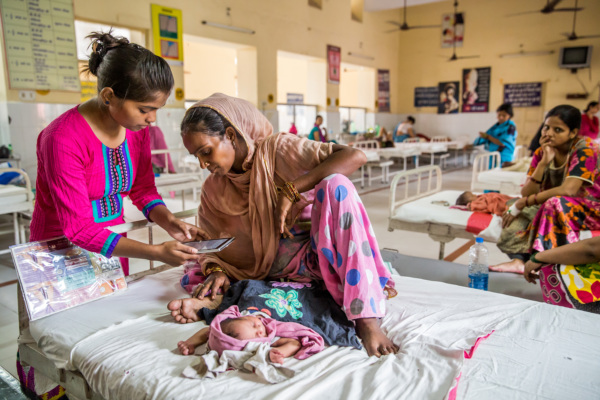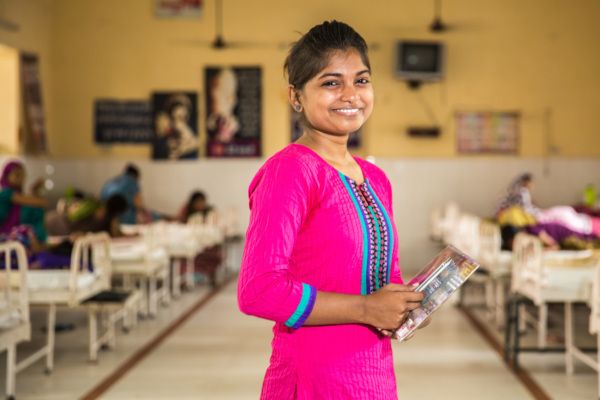Just the Math

When we arrive at Kanpur District Women’s Hospital in Uttar Pradesh, women in brightly-colored saris are already queuing up to be seen. There are men here too. Most are accompanying their wives or shepherding little ones while they wait. They eye us with a mixture of curiosity and wariness. The atmosphere at the hospital is not grim, but it’s definitely intense. We are here as part of a new initiative to strengthen the abilities of local advocates to assess the quality of family planning programs. Today, we are learning about the quality of women’s experiences related to reproductive and maternal health—and the policies and programs that affect these experiences.
There are three obstetricians and gynecologists in the outpatient department at the district hospital and they together see an average of 300 patients per day—a staggering number by any measure. Against this bustling backdrop, family welfare counselor (FWC) Sapna Kumari Kushwaha shines brightly. Business-like with a radiant smile, 24-year-old Sapna spends her days counseling couples and women on their contraceptive options. In the two days we accompany her, we observe her with a range of clients, from an expecting couple hoping to space pregnancies after the birth of their third child, to a daughter-in-law seeking post-abortion care with the support of her mother-in-law, to a mother hoping to learn more about sterilization. We also get to accompany Sapna to the maternity ward where she advises a new mother on post-partum IUCD.

FWCs like Sapna are an important link to ensuring quality reproductive health care for women. In Uttar Pradesh, most of the population is rural or economically disadvantaged and access to quality reproductive health information, supplies, and services is often limited. That is reflected in the state’s maternal mortality ratio of 258 women per 100,000 (the national average is 178 women per 100,000). Access to family planning services is a key part of reducing unintended pregnancies and, consequently, the number of mothers dying in childbirth. In addition to providing family planning counseling, Sapna was trained by Pathfinder International as part of the MATRIKA project to recognize post-partum hemorrhage and pre-eclampsia. If Sapna encounters a woman presenting with any of these conditions, she quickly refers her to a physician or to another higher-level facility. Sapna’s training has made a real difference in her life and in the lives of her clients.
“When I started, I was afraid to even say the word ‘condom,’” Sapna laughs. “Now I can talk to an entire group of people.”
Despite her exuberant spirit, Sapna’s work is not without its challenges. The poor nutritional status of many women means that anemia is a complicating factor in both their eligibility for certain contraceptive procedures and for increasing their risks during pregnancy. Additionally, Sapna uses a tablet and a mobile app to keep track of the number of women she’s counseled as well as the services adopted by them. But there are two methods that she never has—implants, which have not yet been introduced in India, and injectables like Depo Provera, which are not yet available in public facilities. If a woman wants an injectable, Sapna refers her to a private clinic.
And finally, there is one group of clients that Sapna finds it very difficult to help:
Young, unmarried women like herself.
“I almost never see any young women. They are too afraid to come here,” she explains. “There is a lot of stigma in our culture around young women and premarital sex. Most go to private clinics or if they have a good relationship with a pharmacist, they will call and get their contraceptives that way.”
This entrenched stigma associated with sex outside of marriage was something we observed in our interactions with providers (both public and private) and everyday people during our week in Uttar Pradesh. One doctor at a private facility even remarked sanguinely that it was good that unmarried women in India did not yet feel emboldened enough to seek out contraceptives.

When it comes to quality of care for unmarried young people and adolescents, the gaps are very real.
Yet, young women like Sapna embody the progress that is slowly being made in this area. In a society where unmarried men and women rarely interact, there is a hope and power in men and women of all ages trusting a single unmarried woman to be their family welfare counselor. Unsurprisingly, Sapna’s passion for sexual and reproductive health, her independent spirit, and work ethic are creating ripple effects even in her own personal life. Not only does she talk to her younger sister about the range of contraceptive options, she is so known as a great family planning counselor that even her parents refer friends to her.
If more young women like Sapna are able to get the training and support they need, all women in India—married as well as unmarried—will one day be able to access high-quality reproductive health information, services and supplies.
For her part, Sapna isn’t going anywhere:
“I want to keep doing this work,” she says emphatically. “What I look forward to in the future is meeting new clients and helping them live better lives.”
We are fighting back against the onslaught of harmful policies that discard reproductive rights.
Stay informed about the issues impacting sexual and reproductive health and rights.
